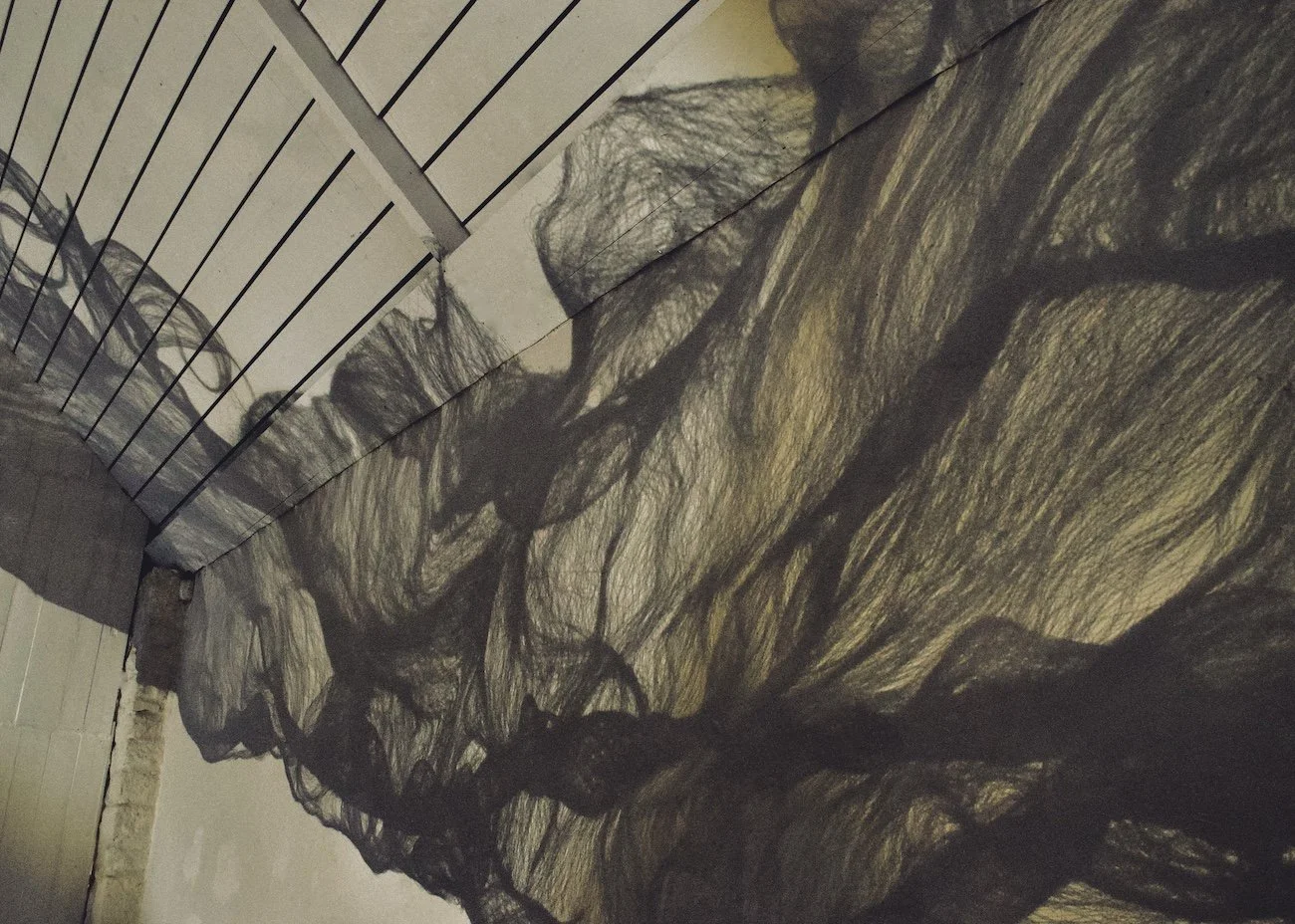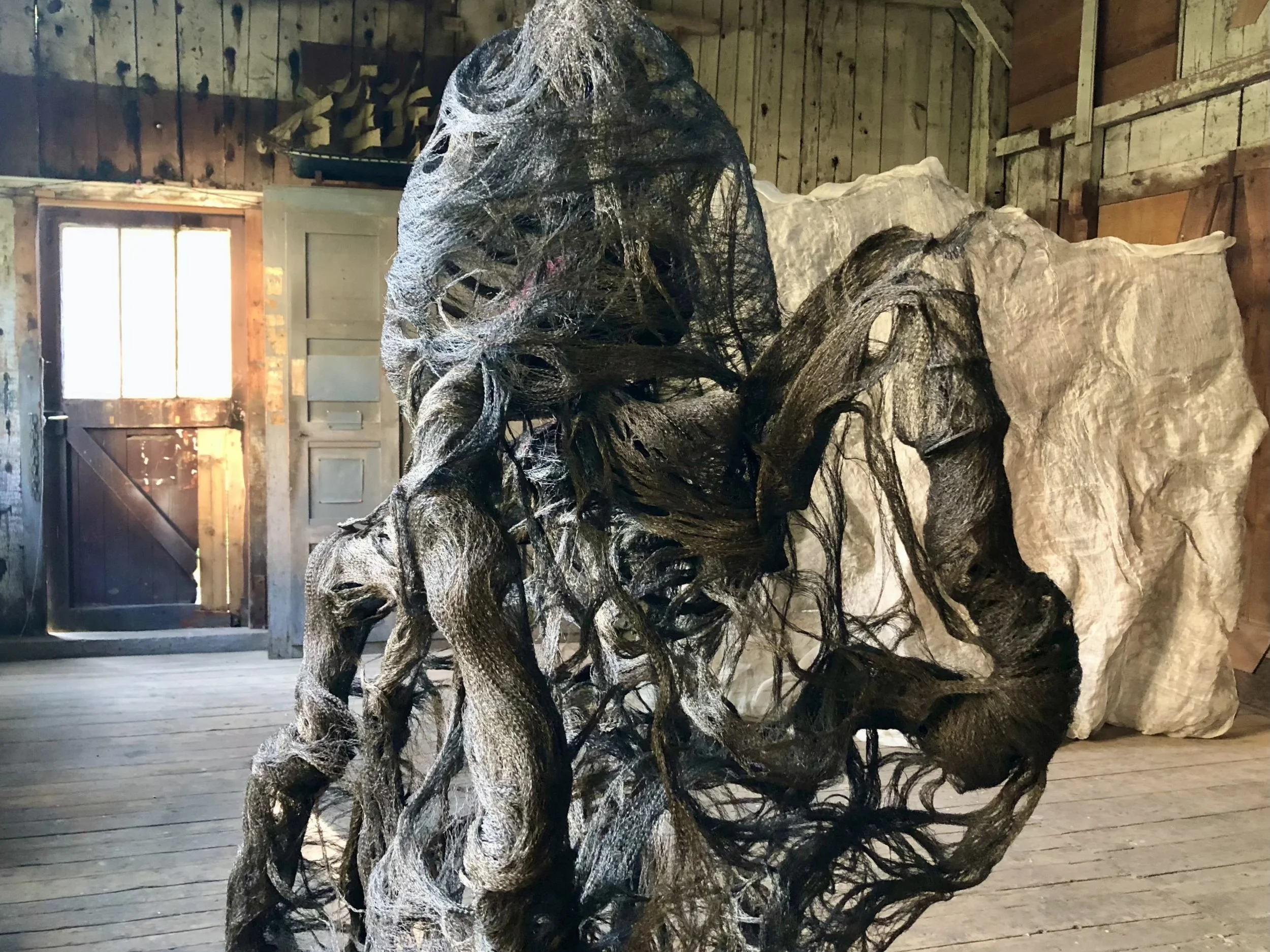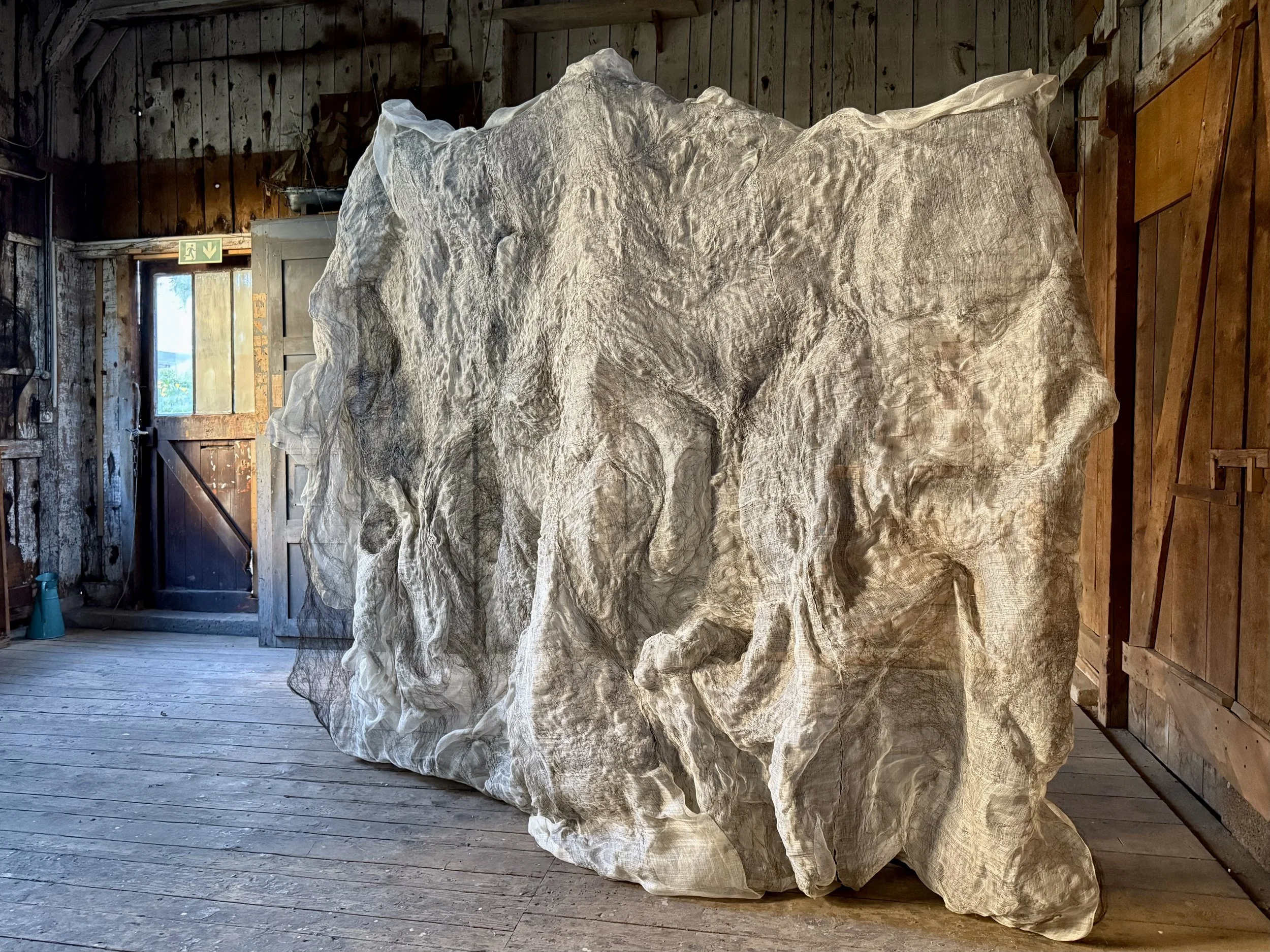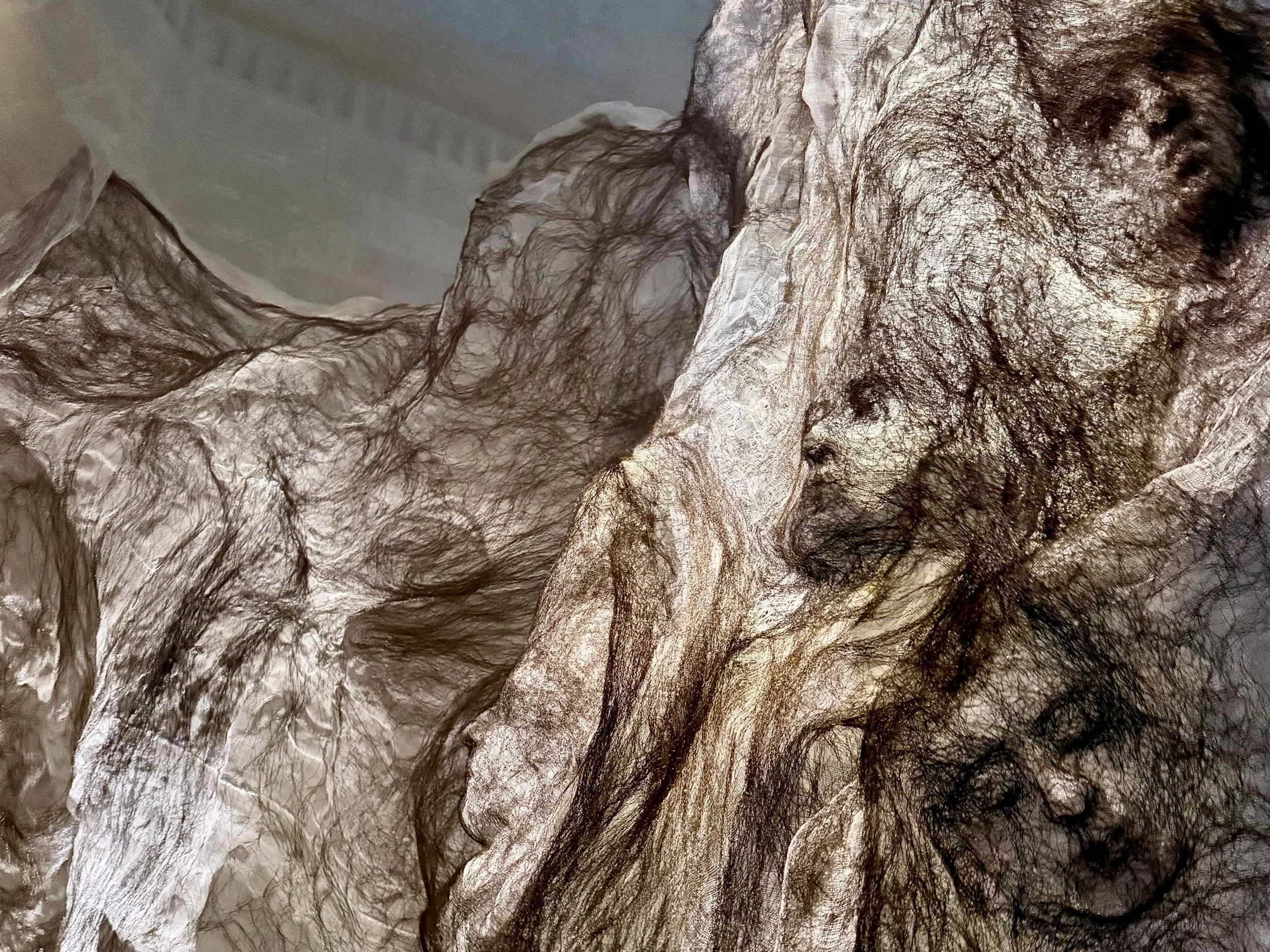Après une carrière de styliste, Christelle développe une démarche artistique à partir d'un fil métallique et compose une matière à mi-chemin entre sculpture et broderie, créant ainsi un trait d'union entre la couture et le dessin dans l'espace.
“Voilà bien une enchevêtreuse. À quoi pense-t-on devant les œuvres de Christelle Balbinot, si, du moins, on a cet irrésistible besoin de raccrocher leur énigme au déjà-vu ? On pense au filet de pêche qui, avant d’être démêlé, repose sur un quai, à une chevelure, surtout au petit matin avant que le peigne n’y remette l’ordre du lisse…
Christelle utilise un matériau que lui offre le rebut industriel : des fils métalliques qu’on emploie à l’électroérosion, capables de découper des matériaux aussi durs soient-ils.
Cette espèce de sculpture est l’écheveau provisoire d’un démêlage inachevé, arrêté par l’artiste quand le lui dicte son œil. Plus que la pensée qui, selon Aristote, a besoin de points d’arrêts, l’artiste interrompt le processus de création pour que l’œuvre émerge — Baudelaire disait que ça le soulage. Tandis qu’on finit toujours par se perdre dans ses pensées, de l’arrêt sur l’œuvre sort une forme individualisée, rivale de la configuration du corps vivant, si elle n’était énigmatique comme dans l’état où Christelle décide d’arrêter son ouvrage…”
Dominique Chateau
"Nous sommes en face et dedans, nous sommes entre proche et lointain, nous sommes dans la boucle du dessin. Le dessin est comme un souffle que la main accompagnerait et, de cette étrange trajectoire, advient une suite d’images anthropomorphes fugaces et incertaines, advient une matière luminescente.
La matière n’est pas volume, elle s’incarne, elle donne de la voix, elle est indomptable. L’œuvre excède l’esprit et la conscience de Christelle qui se trouve emportée par ce vent noir.
Autour de la sculpture règne un curieux silence ; on pourrait penser qu’une fois modelée cette texture peut créer un vide qui inspire une crainte ou tout du moins la sensation d’un phénomène énergétique. La boucle est celle d’un dedans, un espace intime qui transforme des milliers de gestes en vagues solidifiées. On revient sans cesse à ces boucles qui semblent s’amplifier ; elles prennent forme et disparaissent, elles foisonnent, elles nous allègent.
Ce travail est une subtile hybridation de matières lumineuses et d'images projetées, une manière de donner corps à l’immatériel. La sculpture et son images sont intimement liées mais l’ombre ne duplique pas la lumière, elle lui offre un écrin mobile."
Hervé Bacquet
“Pour Christelle Balbinot, tout commence par les mains. Née dans une famille d’ouvriers et d’entrepreneurs, le travail manuel n’était pas une option mais une façon d’être au monde. Dans cet univers, on avançait avec ce que l’on savait faire, pas avec ce que l’on pensait. Produire, bien faire, faire utile : telle était la boussole familiale.
Très jeune, Christelle intègre cette logique. Mais ce qu’on attend d’elle — précision, rendement, efficacité — ne suffit pas à nourrir une intuition plus intime : celle d’un rapport au monde plus libre, plus sensible, plus inventif. Après une formation technique exigeante dans le domaine du textile, elle commence à rencontrer un autre espace. Un espace où la main ne serait plus seulement au service de la production, mais aussi de l’expression.
Ce basculement ne se fait pas du jour au lendemain. Il faut du temps pour déconstruire des réflexes ancrés, pour s’autoriser à expérimenter, à détourner les savoirs acquis, à abîmer la matière pour lui donner une âme. Peu à peu, le geste devient langage, et la main, outil de pensée.
Aujourd’hui, Christelle Balbinot crée à partir de cette lente reconquête : celle d’un geste libéré, affranchi de la logique du rendement. Une main qui sait, mais surtout une main qui cherche.”
Extrait interview Arterie
ENGLISH
After a career as a stylist, Christelle developed an artistic approach based on metallic thread and composed a material halfway between sculpture and embroidery, thus creating a link between sewing and drawing in space.
“That’s quite a tangler. What do we think of when faced with the works of Christelle Balbinot, if, at least, we have this irresistible need to attach their enigma to déjà vu? We think of the fishing net which, before being untangled, rests on a quay, of a head of hair, especially in the early morning before the comb straightens it...
Christelle uses a material provided by industrial waste: metal wires used in wire EDM, capable of cutting materials no matter how hard they may be. This type of sculpture is the provisional skein of an unfinished unraveling, stopped by the artist when his eye dictates it. More than thought which, according to Aristote, needs stopping points, the artist interrupts the creative process so that the work emerges – Baudelaire said that this relieves him. While we always end up getting lost in our thoughts, from stopping at the work an individualized form emerges, rivaling the configuration of the living body, if it were not enigmatic as in the state where Christelle decides to stop its work of art…”
Dominique Chateau
"We are in front and inside, we are between near and far, we are in the loop of the drawing. The drawing is like a breath that the hand would accompany and, from this strange trajectory, comes a series of fleeting and uncertain anthropomorphic images , a luminescent material appears.
The material is not volume, it is incarnate, it gives voice, it is indomitable. The work exceeds the spirit and the consciousness of Christelle who is. found carried away by this black wind.
Around the sculpture reigns a curious silence one could think that once modeled this texture could create a void which inspires a fear or at least the sensation of an energetic phenomenon; from within, an intimate space which transforms thousands of gestures into solidified waves We constantly return to these loops which seem to amplify, they take shape and disappear, they abound, they lighten us.
This work is a subtle hybridization of luminous materials and projected images, a way of giving substance to the immaterial. The sculpture and its images are intimately linked but the shadow does not duplicate the light, it offers it a mobile jewel case."
Hervé Bacquet
“For Christelle Balbinot, everything starts with the hands. Born into a family of workers and entrepreneurs, manual labor wasn't an option, but a way of being in the world. In this world, we moved forward with what we knew how to do, not with what we thought. Producing, doing well, and making something useful: this was the family's guiding principle.
Christelle internalized this logic at a very young age. But what was expected of her—precision, efficiency, effectiveness—wasn't enough to nurture a more intimate intuition: that of a freer, more sensitive, more inventive relationship with the world. After demanding technical training in the textile field, she began to encounter another space. A space where the hand would no longer serve only production, but also expression. This shift didn't happen overnight. It takes time to deconstruct ingrained reflexes, to allow oneself to experiment, to subvert acquired knowledge, to damage the material to give it soul. Little by little, the gesture becomes language, and the hand a tool of thought. Today, Christelle Balbinot creates from this slow reconquest: that of a liberated gesture, freed from the logic of efficiency. A hand that knows, but above all a hand that seeks.”
Interview excerpt Arterie











